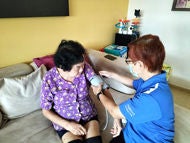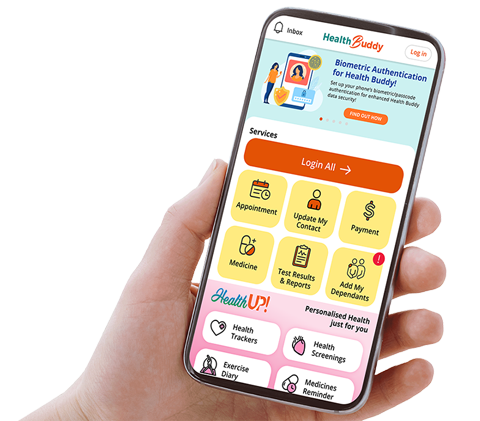What is - Pregnancy Pain Relief In Labour
Expecting a baby is definitely one of the most joyous experiences in your life, so it Is important that the labour and delivery are safe and pleasant. Tolerance to labour pain varies amongst individuals, but it is best for you to be open-minded to all pain relief methods. Your active participation in planning your childbirth together with the help of your obstetrician, the anaesthetist, the midwife and your partner, will help you experience a comfortable and rewarding labour.
What is labour pain all about?
Labour pain is usually divided in to three stages:
- During the 1st stage of labour, uterine contractions occur at regular intervals. These are accompanied by dilation of your cervix to allow your baby’s head to pass into the birth canal. Pain is felt in your lower abdomen and sometimes in your back.
- During the 2nd stage of labour, contractions continue. In addition, bearing-down sensation or pressure helps you to push your baby’s head down the birth canal, stretching the muscles and tissues of the vagina.
- The 3rd stage of labour involves expulsion of the placenta.
All these sensations are conveyed through the nerves to your spine, where messages are transmitted to the brain which releases the pain signal to your body.
It is difficult to predict how long your labour will be. It can range from a few hours to twelve hours or more, but it is important to realise that prolonged pain and stressful labour is undesirable for both yourself and your baby. Resorting to pain relief methods during labour is not an indication of failure, but is a means of having a pleasant birth to which every mother-to-be is entitled.
What can I do to relieve my labour pain?
Different methods are available to relieve labour pain. Effectiveness varies among individuals, but it is helpful to familiarise yourself with the more common methods before you go into labour, so that you will be able to come to a quick decision when necessary.
Epidural Analgesia (EA) / Combined Spinal-Epidural Analgesia (CSEA)
Epidural Analgesia is one of the most effective and reliable ways of relieving labour pain. An injection is done to locate the epidural space within the backbone canal and a fine plastic tube is inserted. Pain relief is accomplished by injecting painkillers through the small tube. Medication can be continued through this small tube via an automated infusion pump, or a patient-controlled pump.
In Combined-Spinal-Epidural Analgesia, in addition to the above EA, an initial dose of pain killers is given into the spinal space for pain relief. CSEA takes effect faster than EA. A fine tube is also inserted to deliver the painkillers continuously throughout labour subsequently.
The anaesthetist will decide if EA or CSEA will be used depending on the stage and progress of labour.
Complete pain relief cannot be guaranteed throughout labour as different women respond differently. Also, effective pain relief must be balanced against the side effects, and some degree of pain may still be felt with EA/CSEA, especially near the time of delivery of the baby.
Benefits of EA/CSEA
This method of pain relief has the following benefits:
- It is safe and gives consistent reliable pain relief in labour
- The placenta and therefore the baby may get better blood flow during and between contractions
- It reduces many stress-related responses of the body to pain, which is beneficial for women with high blood pressure, pre-eclampsia, heart problems or diabetes
Side effects and complications of EA/CSEA
It is generally safe to receive EA/CSEA. The side effects are usually predictable, short-lived and not harmful. They can be divided into:
Common side effects
- Loss of feeling. Numbness of the legs and lower part of the body may occur. Bladder sensation may also be lost, and hence you may not have the urge to pass urine.
- Muscles weakness. Some weakness of the legs may occur but this is usually not severe, and the weakness should wear off when the drug wears off.
- Shivering. This may occur although you may not be feeling cold. This usually does not require any treatment.
- Itch. Generalised mild itch is more common after CSEA than EA. This usually does not need any treatment as it is self-limiting.
- Nausea/vomiting. This may result from a lowering of blood pressure with the application of CSEA. Proper positioning of the patient’s body and blood pressure raising drugs may easily treat a reduction of blood pressure.
- Fever. The use of labour EA may be associated with development of fever, but rarely results in overt fever. This is unlikely to cause harm to the fetus. However, if your fever is higher than 38 degrees, you and your baby may be investigated for infection. Antipyretic/antibiotic treatment may be prescribed which may result in an increased length of hospital stay.
- Effect on the baby. EA/CSEA does not harm the baby although some transient drop in the baby’s heart rate may occur. If this occurs, it is usually temporary, and it is treatable with fluids and medications.
- Bruising and backache. Occasionally you may experience bruising over the injection site. It usually resolves in a few days. Backache is common in pregnant women and after delivery, with or without an epidural. Surveys have not been able to establish the link between severe long-term backache with EA/CSEA.
- Paraesthesia/numbness. It is not uncommon to experience mild electric shock during the insertion of the epidural catheter. Occasionally, some patients may have persistent numbness over some areas on their legs. This is usually temporary and will go away in a few days.
- Spinal headache. The risk of spinal headache is about 1% after EA/CSEA. This characteristic headache is felt in the forehead and the back to the head and neck and is worsened when in an upright position. It usually goes away in a few days and is treatable with simple pain medication. Stronger medications and a procedure called the “epidural blood patch” can be used to treat the headache if it is severe.
- Failure to achieve pain relief. Rarely the epidural may not work or you may get a patchy block or one-sided block. This may be due to many reasons such as migration of epidural catheter out of the epidural space (with movement or wet dressing), suboptimal placement of the catheter and disconnection of the catheter from the infusion pump. Sometimes, if there is rapid progression of labour (rapid cervix dilation in a short period of time), the EA/CSEA may not have adequate time to work. If there are any problems with the epidural, or if the pain becomes unbearable after EA/CSEA, you should inform your anaesthetist immediately so that he/she can attend to you and rectify the problem. The epidural catheter may have to be reinserted in some instances through a repeat injection in the back.
- Accidental high block
- Breathing difficulty
- Convulsions
- Permanent nerve damage, resulting in numbness or weakness in thigh, leg or foot
- Serious spinal/brain infection
Those who smoke, are overweight, diabetic, have high blood pressure, or previous heart disease are at higher risk of these complications.
Remifentanil Patient-Controlled Analgesia (Remifentanil PCA)
Patient-controlled analgesia (PCA) is an intravenous drug delivery system that allows you to administer your own pain killers when needed. The PCA device is programmed to administer a fixed dose of remifentanil (a short-acting opioid) upon demand, with appropriate pre-set limits on maximal dose of medications delivered in a fixed time interval. For effective use of PCA, you can activate a dose of painkillers when you feel the onset of a contraction. You will also be provided with oxygen supplementation and continuous monitoring of oxygen saturation thorough a finger-probe for safety.
Current medical literature suggests that Remifentanil PCA is less effective than epidural analgesia in providing labour pain relief. It may be considered in patients who cannot or prefer not to have epidural analgesia e.g. bleeding tendencies, previous spine surgery.
Side effects are generally predictable and short-live, but an anti-dote may need to be given in severe cases.
These include nausea/vomiting, drop in maternal heart rate or blood pressure, respiratory depression and sedation of the mother.
Remifentanil has not been shown to harm the baby in current studies. However, there are theoretical risks of causing respiratory depression and sedation in the newborn. If this occurs, a neonatologist will attend to the baby immediately.
Life-threatening complications are very rare. These include muscle rigidity, breathing difficulty and complete cessation of breathing.
Breathing and Relaxation
These refer to the breathing exercises and relaxation techniques which you would have probably practised during your antenatal class. When labour starts and you begin to feel pain, concentrating on your breath and breathing out loud may help you relax.
With the help of your partner, your discomfort may also be relieved by gentle massage on your back. You may find this adequate in early labour, but many mothers may have to seek other methods of pain relief when contraction pains become more severe.
Nitrous Oxide Gas / “Laughing gas”
This gas, commonly known as “laughing gas” is mixed with oxygen. To use this method, a mask or mouth piece draws gas from a machine beside the bed. You need to take deep and steady breaths before each contraction as it takes about 20-30 seconds for the gas to be effective. The gas is safe. It does not build up in your or your baby’s body. However, the gas may make you feel light-headed, drowsy or nauseous. Not all mothers find this method of pain relief effective.
Injection of drugs
Pain relieving drugs such as pethidine (which is the most commonly used) can be injected into your muscles to reduce your labour pain, but their efficacy varies among individuals. They tend to make some nauseous or drowsy and reduce the mother’s cooperation in pushing. In addition, these drugs cross the placenta to the baby to make him/her drowsy and this depresses the baby’s breathing after he/she is born. If this happens, an “antidote” can be given to your baby to reverse these side effects.
Your anaesthetist will advise you on the appropriate type of pain relief method after discussion with you and your obstetrician. Please feel free to direct any questions or express any of your concerns to your anaesthetist.
Pregnancy Pain Relief In Labour - Other Information
Contributed by
The information provided is not intended as medical advice. Terms of use. Information provided by SingHealth.
Condition Treated At
Department
Obstetrics & Gynaecology
Department
Obstetrics and Gynaecology (O&G) Centre
Department
Obstetrics and Gynaecology
Department
Women's Anaesthesia
Department
Obstetrics & Gynaecology
Get to know our doctors at SingHealth Hospitals in Singapore.
Get to know our doctors at SingHealth Hospitals in Singapore. here.




















